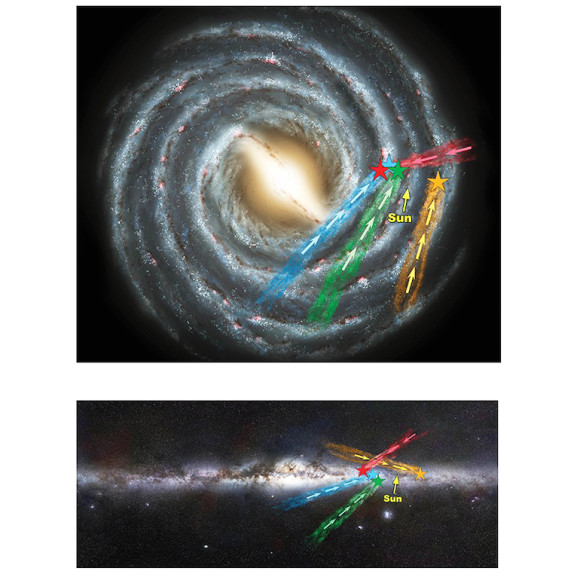
Astronomers have discovered a surprising new class of solitary stars moving fast enough to escape the gravitational grasp of the Milky Way galaxy.
“These new hypervelocity stars are very different from the ones that have been discovered previously,” says Vanderbilt University graduate student Lauren Palladino, lead author on the study. “The original hypervelocity stars are large blue stars and appear to have originated from the galactic center.
“Our new stars are relatively small—about the size of the sun—and the surprising part is that none of them appear to come from the galactic core.”
The discovery came as Palladino, working under the supervision of Kelly Holley-Bockelmann, assistant professor of astronomy at Vanderbilt, was mapping the Milky Way by calculating the orbits of Sun-like stars in the Sloan Digital Sky Survey, a massive census of the stars and galaxies in a region covering nearly one quarter of the sky.
“It’s very hard to kick a star out of the galaxy,” says Holley-Bockelmann. “The most commonly accepted mechanism for doing so involves interacting with the supermassive black hole at the galactic core. That means when you trace the star back to its birthplace, it comes from the center of our galaxy.
“None of these hypervelocity stars come from the center, which implies that there is an unexpected new class of hypervelocity star, one with a different ejection mechanism.”
Big kick
Astrophysicists calculate that a star must get a million-plus mile-per-hour kick relative to the motion of the galaxy to reach escape velocity. They also estimate that the Milky Way’s central black hole has a mass equivalent to four million suns, large enough to produce a gravitational force strong enough to accelerate stars to hyper velocities.
The typical scenario involves a binary pair of stars that get caught in the black hole’s grip. As one of the stars spirals in toward the black hole, its companion is flung outward at a tremendous velocity. So far, 18 giant blue hypervelocity stars have been found that could have been produced by such a mechanism.
Now Palladino and her colleagues have discovered an additional 20 sun-sized stars that they characterize as possible hypervelocity stars.
“One caveat concerns the known errors in measuring stellar motions,” she says. “To get the speed of a star, you have to measure the position really accurately over decades. If the position is measured badly a few times over that long time interval, it can seem to move a lot faster than it really does.
We did several statistical tests to increase the accuracy of our estimates. So we think that, although some of our candidates may be flukes, the majority are real.”
The astronomers are following up with additional observations.
Big question
The new rogues appear to have the same composition as normal disk stars, so the astronomers do not think that their birthplace was in the galaxy’s central bulge, the halo that surrounds it, or in some other exotic place outside the galaxy.
“The big question is: what boosted these stars up to such extreme velocities? We are working on that now,” says Holley-Bockelmann.
Katharine Schlesinger from the Australian National University, Carlos Allende Prieto from the Universidad de La Laguna in Spain, Timothy Beers from the National Optical Astronomy Observatory in Tucson, Young Sun Lee from New Mexico State University and Donald Schneider from Pennsylvania State University also contributed to the discovery.
Funds from the Graduate Assistance in Areas of National Need program, National Science Foundation, Physics Frontier Center, the Aspen Center for Physics, the Alfred P. Sloan Foundation, and the US Department of Energy Office of Science supported the work.
The findings are published in the Astrophysical Journal.











